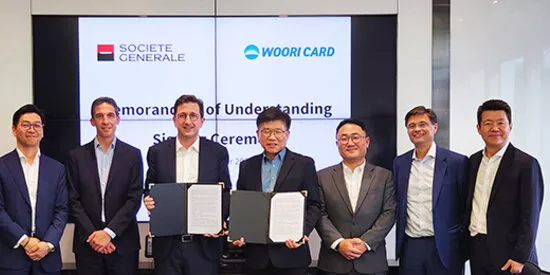
Ripple effect: Floating solar project sets a template for Southeast Asia
The first large-scale floating solar installation in Indonesia will set a template for a growing number of similar projects planned in Southeast Asia and beyond. As well as helping Asia reduce its reliance on coal-fired power, this technology offers some compelling advantages over other clean energy solutions.
Construction has begun on what will be the largest floating photovoltaic (FPV) power project in Southeast Asia, the 145 megawatt (MW) Cirata power plant, located in West Java, Indonesia.
Pembangkitan Jawa Bali Masdar Solar Energi (PMSE), a joint venture between renewable energy specialist Masdar and Indonesia’s electricity utility PT Perusahaan Listrik Negara1 (PLN), closed a green loan recently to finance the project, with Societe Generale as Mandated Lead Arranger, Documentation Bank and Hedging Bank.
The 250-hectare installation, located on the Cirata reservoir, is Indonesia’s first floating solar project and, once operational in the fourth quarter of 2022, will generate enough clean energy to supply 50,000 homes and offset 214,000 tons of carbon emissions2. But beyond generating clean power like other renewable energy technologies, floating solar offers some compelling environmental, technological and economic advantages.
A solution with cost and environmental benefits
Locating solar arrays on large, unshaded bodies of water is a cost-effective option that keeps valuable land for other purposes, such as agriculture. While land for ground-mounted installations is limited in many countries, particularly in Southeast Asia, coastal regions and large lakes or reservoirs allow developers to legitimately bypass some of the land acquisition and approval processes that can complicate land-based projects. Floating solar projects can therefore be developed faster and without significant impact on adjacent land use.
Floating PV projects that co-locate with established hydroelectric infrastructure, as the Cirata project, may also be able to take advantage of existing infrastructure (such as access roads, electric substations and transmission lines) to reduce installation costs.
Floating PV infrastructure can be designed to avoid interfering with other water uses, such as aquaculture. In some cases, the shade can even foster greater biodiversity by discouraging algae growth, creating a more hospitable environment for marine life.
The shade from the floating PV installation has other advantages, too: cooler water limits evaporation, helping to conserve water resources – increasingly critical due to the effects of atmospheric warming. The temperature of the water also makes the technology more efficient, as PV panels have a negative temperature coefficient (the cooler they are, the more energy they produce) and ambient air temperature on water is often lower than the adjacent land environment. According to the World Bank, locating PV panels on water can boost their electricity-generating efficiency by as much as 10%3.
An asset class with deep potential
The Cirata project is the third solar development Societe Generale has financed in Indonesia (the first two being ground mounted) and the second floating solar project it has financed (the original one is also in Asia – in Taiwan).
After a slow start compared to land-based equivalents, floating PV is now a fast-growing asset class. Singapore, Malaysia, Thailand and Vietnam are all either planning or actually installing FPV parks on dams or reservoirs4. A 2020 study by the Institute for Energy Economics and Financial Analysis (IEEFA) estimated the market potential for floating PV in the ASEAN region could be at least 24GW.5
“Southeast Asia has high potential for large-scale floating PV plants, and their clear environmental benefits make these projects good candidates for green financing,” said Daniel Mallo, Head of Natural Resources and Infrastructure, Asia Pacific at Societe Generale. “As the region continues to accelerate its initiatives to reduce reliance on coal-fired power generation, floating solar offers a positive route forward.”
Green light for clean power
The process to reach financial close on the Cirata project faced substantial logistical barriers as the COVID-19 pandemic persisted and all parties demonstrated new levels of commitment and innovation to deliver the funding solution despite the challenges involved.
The project financing was structured according to the Green Loan Principles, a set of principles developed by the Loan Syndications and Trading Association, the Asia Pacific Loan Market Association and the Loan Market Association providing a framework for the financing of green and sustainable projects.
“The support we have received for our first renewable energy project in Southeast Asia is a clear sign of the potential for floating solar in the region,” said Mohamed Jameel Al Ramahi, Chief Executive Officer of Masdar. “Our lenders, partners and the Government of Indonesia share our vision of the economic and environmental benefits of this technology in the energy transition.”
1 Through its subsidiary PT Pembangkitan Jawa‑Bali
2 https://news.masdar.ae/en/news/2021/08/03/08/07/masdar-joint-venture-reaches-financial-close-and-starts-construction
3 https://openknowledge.worldbank.org/handle/10986/31880
4 https://asian-power.com/power-utility/news/floating-solar-farms-make-waves-in-southeast-asia
5 https://ieefa.org/wp-content/uploads/2020/06/Is-Combined-Floating-Solar-and-Hydro-the-Energy-Solution-for-ASEAN_July-2020.pdf




